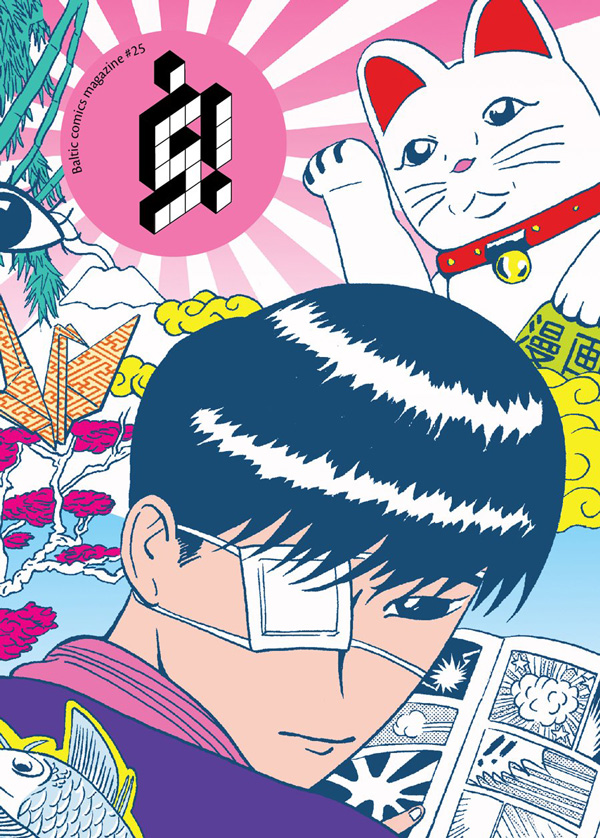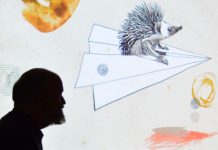This collection of gaijin mangaka — that is, Manga style comics made by non-Japanese creators — who graduated to the style of Gekiga — that is, serious dramatic Manga, as opposed to, say, Sailor Moon. It’s a heavy and obtuse collection, with many of the creators taking stylistic cues from the form, but infusing it with their own points of emotional focus, and even delivery, but it’s the kind of daring and artful experimentation I’ve come to expect from the Baltic comics anthology S!
Most of these are not ordinary in that sense that you think of the classics of Gekiga, like the work of Tezuka, nor are they necessarily linear at all, much more married to abstract story-telling styles and even poetry that the traditional presentation of drama.
Italian cartoonist Vincenzo Filosa offers an over-the-top burst of silent surrealism involving battling religious figures and monstrous food, while Ben Marcus follows this up with a retro science fiction slice in beautiful noisy purple that reads a bit like agit prop parody from the 1980s. Nou’s “Ring Mark” follows the brief life cycle of a flower creature in bursts of color.
Linear action appears in the form of Argentinean cartoonist Berliac’s “Moriyama’s Dog,” in which an agoraphobic and paranoid cartoonist dog sits and finds his own mania growing as he overcomes a creative block. Aseyn, a Parisian cartoonist, follows up with a bit of semi-awake poetry rendered through spare and often mysterious visuals. The untitled piece by Mickey Zacchilli has a similar poetic quality, though with wild, undisciplined art that challenges the expected look of manga as the character’s monologue contemplates the creation of art. GG’s “Lapse” returns to silence, using the starkness of a nosebleed to capture the despair of mortality in a medical setting.
Gloria Rivera’s beautifully rendered “Domestic Scene” offers a muddy vision of a very private moment between two people trying to talk things out, but reaching no conclusions, with Rivera’s art, which doesn’t resemble what one thinks of as Manga at all, capturing the chaotic emotions involved.
Luis Yang uses the classic schoolgirl look from Manga to a creepy end, purportedly about a couple meeting on a rooftop to explain their feelings, but the story is peppered with lots of macabre imagery, as well as elusive dialogue, that gives it a heaviness and a foreboding that you can’t explain.
Dilraj Mann’s “Everyday” is stylishly rendered, concerning itself with the building of a city, reports of superhero, and the repeated image of a despairing man barely able to get out of bed. All of it is leading to calamity, but is it one of reality or psychology? Or both feeding off each other?
There are far more mysteries than conclusive answers in the stories presented here, but the creators are skilled at taking their difficult ideas and rendering them with strong visual accompaniment. I’ve mentioned the ones I liked best, and though some of the stories are more challenging than others — seriously, surrealist defiance runs deep in this volume — there’s nothing in here I would say is bad work. But I might suggest pacing out the stories as you read them rather than piling each entry in the anthology on top of each other, since each has a tendency to drown out what came before it, thanks to the intensity of the presentations.








